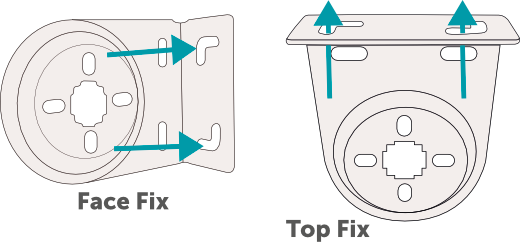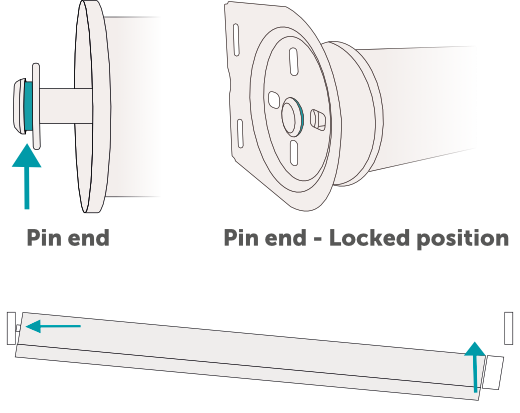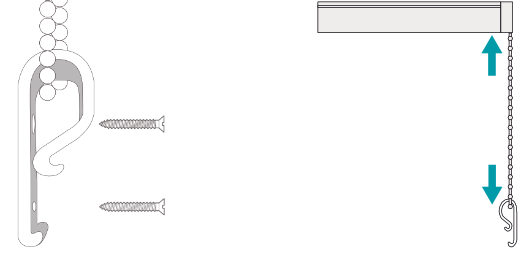How to Install XL Premium Roller Blinds
-
You overcame the measurement minefield and now you must face the final challenge – installing your roller blind. Honestly, it isn’t half as bad as you think it is, and with this very easy guide, you’ll be done in no time. Grab a cuppa and have a quick read through our instructions to familiarise yourself before you get started. The tools you’ll need are: drill with 5mm drill bit, tape measure and a screw driver. We supply the screws needed (4 long and 4 short, and 4 raw masonry plugs).
Step 1 - Fitting the Brackets
For our wider blinds, you'll find that the brackets are the same for both sides, and this is to ensure functionality whilst the blind is in situ.
Place your first bracket into position, ensuring your blind won't get in the way of any handles or vents. The brackets can be top fixed or face fixed.
Measure the distance from the window to the bracket and mark the spot you need to drill and repeat this on the other side, ensuring the brackets are level (a spirit level can help gauge this).
Drill the hole, starting with a smaller pilot hole and then going to the wider 5mm drill bit. You should use a thin wood drill bit if attaching it to the window frame and consider using the smaller screws supplied. If you are fitting the blind to the wall, use a masonry drill bit with the wall plugs provided (make sure the drill bit and the wall plugs are the same size).
Important Note: Ensure there is enough space at the pin-end bracket (the end opposite the mechanism) to allow for free movement of the barrel. The pin-end of the blind is sprung to allow for easy removal of the blind and should not be fully compressed as this can cause the barrel to rub on the bracket and make operation stiff. -

Step 2 - Fitting Blind and Optional Bracket Covers

Once the brackets are up you can add the bracket covers if you ordered them. These optional extras will simply slide onto the brackets, giving your blind a professional and clean finishing touch if outside of the recess. The bracket covers are designed to have a nice tight fit, if you ever need to remove them insert a flat screwdriver into the cutout at the bottom inside of the cover and twist, this will release the cover.
Note: If you wish to use bracket covers on a blind going into the recess, be sure to account for the size of the cover before screwing in the brackets as it might be a tight fit.
Now it is time to fit the blind. First, attach the end opposite the controls (known as the pin-end), push gently against the pin-end to suppress the pin, lift the control end up and attach to the control end bracket. Allow the blind to drop into its locked position. The bracket needs to sit between the two collars, on the part coloured blue in the illustration. Once locked in place, the blind will need to be pushed up first if it is to be removed and then pushed towards the pin end for the spring to compress, allowing you to pull the mechanism end out.

Step 3
 Finally, attach the relevant child safety devices.
The cord retainer should be at the maximum distance possible from the control mechanism, keeping the chain taut. Put the retaining device on the wall, mark the hole with a pencil, drill the hole, insert a wall plug and screw the device to the wall. And there you go – your blind is safely up, so all that’s left is to give it a quick test.
Finally, attach the relevant child safety devices.
The cord retainer should be at the maximum distance possible from the control mechanism, keeping the chain taut. Put the retaining device on the wall, mark the hole with a pencil, drill the hole, insert a wall plug and screw the device to the wall. And there you go – your blind is safely up, so all that’s left is to give it a quick test.Changing the Roll
If you wish to change the way the blind is rolled, which is sometimes a good idea if you are trying to avoid window handles or other protruding objects, then simply unravel the blind all the way to the metal barrel and then re-roll it in the direction you want.
Note : Make sure your hands are clean, you wouldn’t want to mark you nice new shiny blind! It’s also a good idea to have your hands at equally lengths to ensure that when you re-roll the blind the roll is even, this will prevent any gather at one end and exposed barrel at the other.
